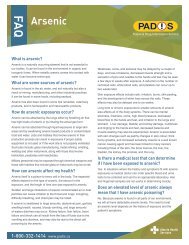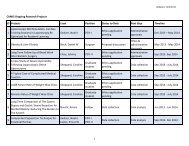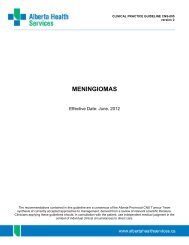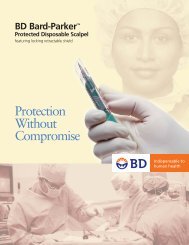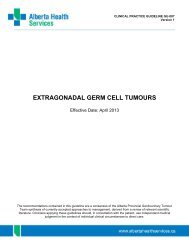Chronic Lymphocytic Leukemia - Alberta Health Services
Chronic Lymphocytic Leukemia - Alberta Health Services
Chronic Lymphocytic Leukemia - Alberta Health Services
Create successful ePaper yourself
Turn your PDF publications into a flip-book with our unique Google optimized e-Paper software.
CLINICAL PRACTICE GUIDELINE LYHE-007<br />
Version 2<br />
Before the initiation of treatment, patients with a white blood cell (WBC) count higher than 50,000/mm 3<br />
should be adequately hydrated and monitored frequently. In patients with previous episodes of tumour<br />
lysis syndrome, consultation with a nephrologist should be considered. Where overt uremic symptoms are<br />
present, dialysis may be necessary in order to prevent acute renal failure. In outpatients, frequent<br />
monitoring of serum electrolytes and uric acid is recommended as a preventative measure. (61)<br />
Prophylactic allopurinol (300 mg/day orally) is necessary when a rapid lysis of large numbers of<br />
lymphocytes is anticipated (initial WBC count >200 x 10 9 /L). Allopurinol should also be given to patients<br />
with significant renal dysfunction or chronic hyperuricemia. In the advent of tumour lysis syndrome it may<br />
be necessary to interrupt treatment until symptoms are resolved. Cardiac activity should be monitored<br />
continuously, and frequent monitoring of electrolyte levels is recommended. (61) Rasburicase may also be<br />
considered for the prevention and treatment of tumour lysis syndrome in patients with a high WBC count,<br />
coexistent renal insufficiency, and an allopurinol intolerance or allergy.<br />
Close monitoring for tumour lysis syndrome is recommended for patients with lymphocytosis greater than<br />
30 x 10 9 /L who are receiving a first cycle of rituximab. Consideration may be given to dividing the dose<br />
over two days for the first infusion.<br />
Blood product support. Transfusion-related graft-versus-host disease has been described in patients<br />
actively receiving fludarabine or alemtuzumab. Canadian Blood <strong>Services</strong> recommends that patients on<br />
fludarabine or alemtuzumab should receive irradiated and cytomegalovirus-negative blood products.<br />
GLOSSARY OF ABBREVIATIONS<br />
Acronym Description<br />
AIHA autoimmune hemolytic anemia<br />
β2M beta-2-microglobulin<br />
BMI Body mass index<br />
CALG-B Cancer and <strong>Leukemia</strong> Group B<br />
CFAR cyclophosphamide + fludarabine + alemtuzumab + rituximab<br />
CI confidence interval<br />
CIRS Cumulative Illness Rating Scale<br />
CLL chronic lymphocytic leukemia<br />
CR complete response<br />
CrCl creatinine clearance<br />
DAT direct antiglobulin test<br />
DLBCL diffuse large B-cell lymphoma<br />
ECOG Eastern Cooperative Oncology Group<br />
FC fludarabine + cyclophosphamide<br />
FCR fludarabine + cyclophosphamide + rituximab<br />
FISH fluorescence in situ hybridization<br />
FR fludarabine + rituximab<br />
HR hazard ratio<br />
IgG immunoglobulin G<br />
IgVH immunoglobulin heavy chain variable regions<br />
ITP idiopathic thrombocytopenia purpura<br />
IV Intravenous<br />
IWCLL international workshop on chronic lymphocytic leukemia<br />
MBL monoclonal B-cell lymphocytosis<br />
OR overall response<br />
OS overall survival<br />
PC pentostatin + cyclophosphamide<br />
PCR pentostatin + cyclophosphamide + rituximab<br />
PCR assay polymerase chain reaction assay<br />
Page 14 of 23



